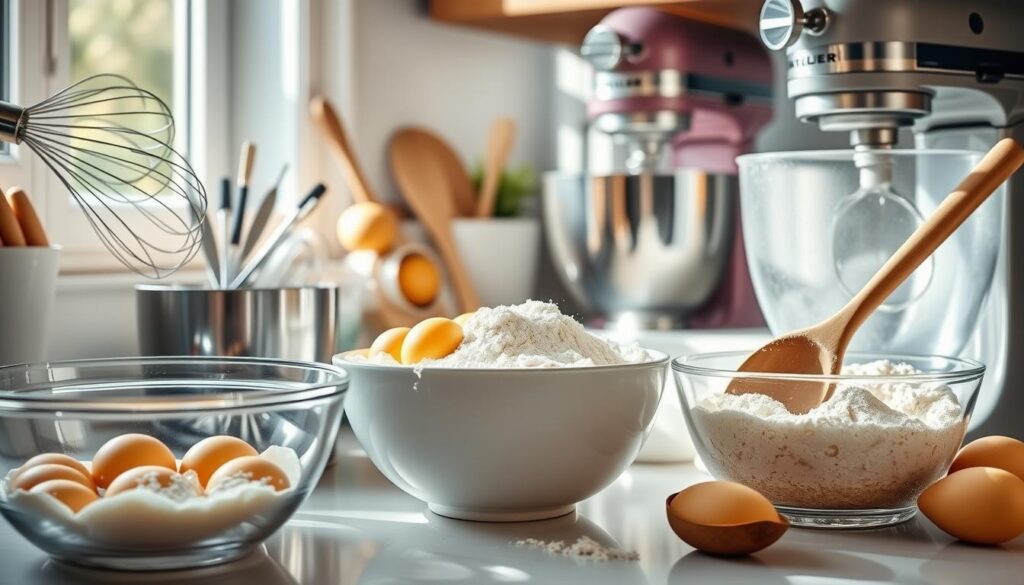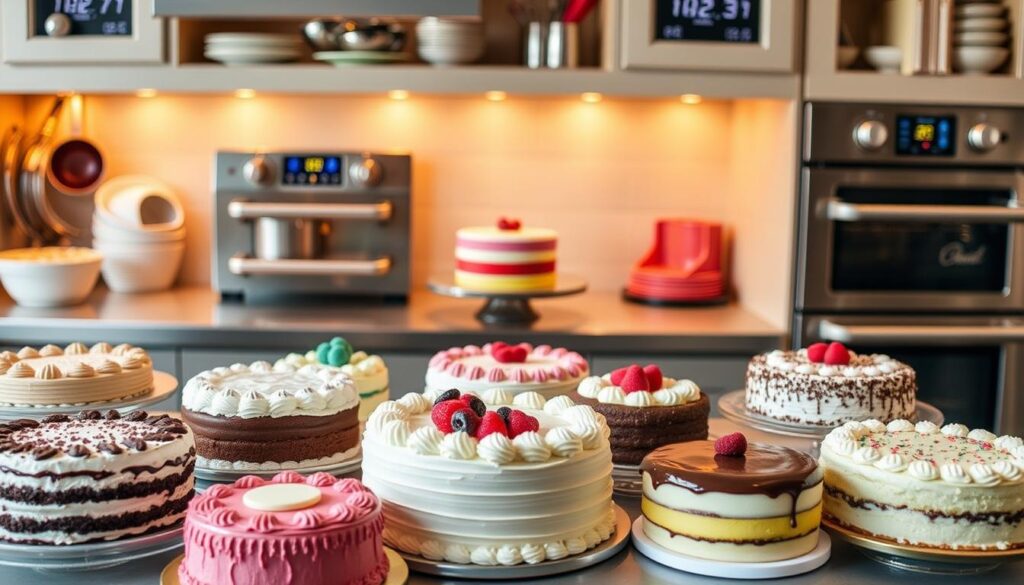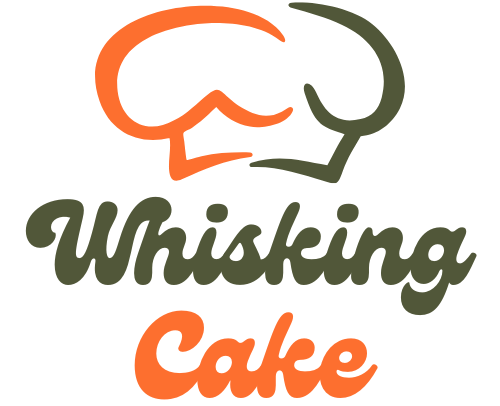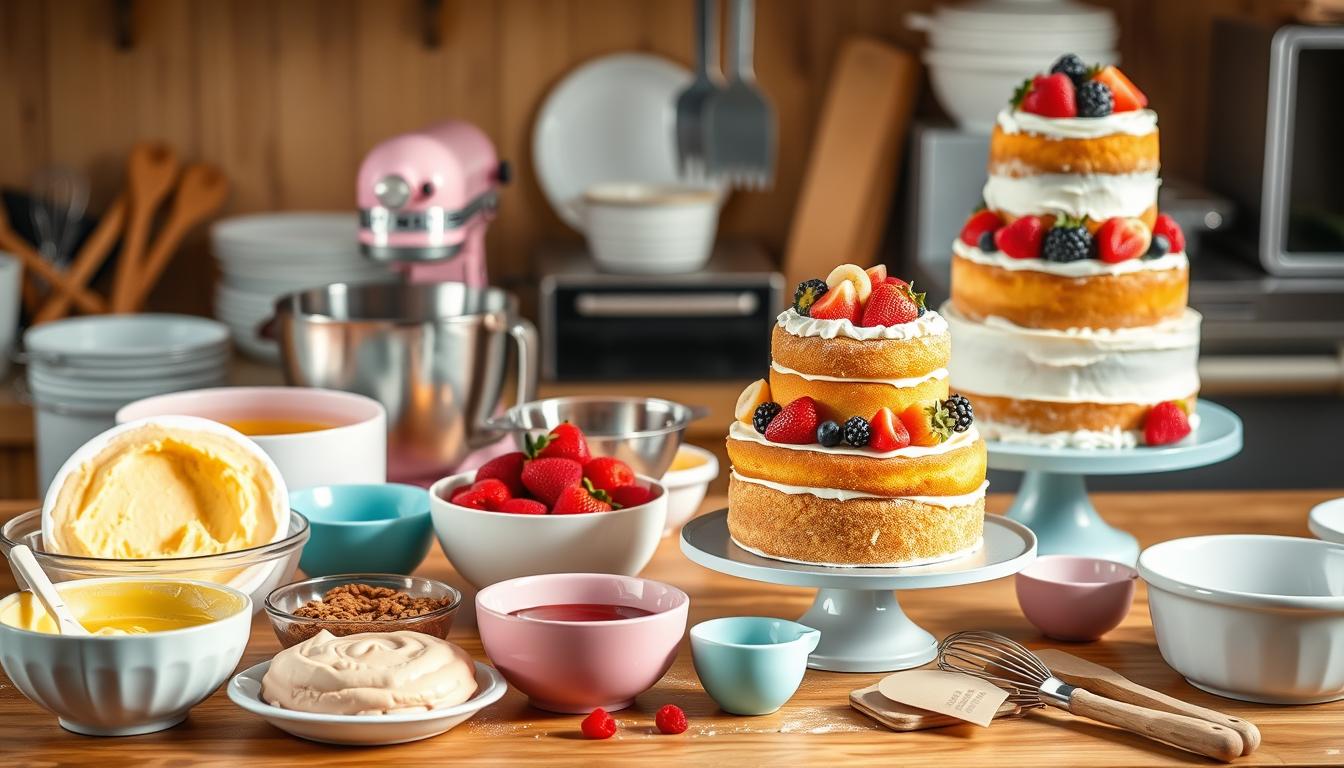Baking a perfect round cake can take your desserts from good to great. It doesn’t matter if you’re new to baking or have years of experience. Making a round cake well takes skill, patience, and some special tricks.
Creating a delicious round cake is more than just following a recipe. It’s about knowing the science behind baking. You need to pick the right ingredients and mix them just right. Every step is important to make a cake that’s moist and tender, and will wow your loved ones.
Professional bakers know that baking a round-cake is not easy. It takes precision, knowing how ingredients work together, and being open to learning from each try.
Table of Contents
Essential Ingredients for Perfect Round Cakes
Making a delicious bakery cake or pastry cake is all about the ingredients. Each one is important for turning simple things into a stunning round cake that pleases everyone.
Baking is a science where every ingredient counts. Let’s look at the key parts that make your pastry cake stand out.
Understanding Different Types of Flour
Flour is the base of your cake. Different types change the texture and taste:
- Cake flour: Lowest protein, makes the cake soft
- All-purpose flour: Good for most, has moderate protein
- Bread flour: High protein, not good for soft cakes
The Role of Leavening Agents
Leavening agents are key for light, fluffy cakes. They help your cake rise and get the right texture.
| Leavening Agent | Purpose | Typical Quantity |
|---|---|---|
| Baking Powder | Creates lift and volume | 2 tsp per cake |
| Baking Soda | Balances acidity | 1/2 tsp per cake |
Importance of Quality Vanilla and Flavorings
Premium vanilla extract makes your cake amazing. Use pure vanilla for the best taste.
« In baking, quality ingredients make all the difference. » – Professional Baker’s Secret
Remember, using the right amounts and top-notch ingredients is key. This will help you make a round cake that wows everyone.
How to Achieve the Perfect Round Cake Texture
Making a delicious layered cake or celebration cake is all about mastering cake texture. It’s about knowing how ingredients work together and using the right mixing techniques.
- Avoid over-mixing the batter
- Use ingredients at room temperature
- Incorporate air carefully during mixing
- Understand leavening agent roles
« The difference between a good cake and a great cake is in the details of its texture. » – Professional Baker
When you’re making your celebration cake, mixing technique is key. Over-mixing can make the cake dense and tough. Stop mixing when the dry ingredients are just combined.
| Mixing Technique | Impact on Cake Texture |
|---|---|
| Under-mixing | Uneven ingredient distribution |
| Over-mixing | Tough, chewy texture |
| Proper mixing | Light, tender crumb |
Temperature is also important for a perfect layered cake. Ingredients at room temperature mix better, leading to a more even texture. Try to have eggs, butter, and milk around 70°F before mixing.
Remember, the more you bake, the better you’ll get. Each cake you make brings you closer to creating a delightful, light, and fluffy texture that will wow your guests.
Proper Measuring Techniques for Round Cake Success
Baking the perfect birthday cake or special occasion cake needs precise ingredient measurement. Small changes can greatly affect your cake’s texture, taste, and success. Learning to measure ingredients accurately is key for home bakers.
Mastering Wet and Dry Ingredient Measurements
Different ingredients need different measuring methods. For dry ingredients like flour, gentle handling is crucial. Here’s a pro tip: spoon flour into measuring cups and level with a knife. Don’t scoop flour directly from the bag, as it can make cakes dense.
Temperature Considerations for Ingredients
Ingredient temperature is vital for the perfect special occasion cake. Eggs and butter should be at room temperature for smooth blending. Try to take ingredients out of the fridge 30-45 minutes before baking.
Weight vs. Volume Measurements
Professional bakers often use weight measurements for the best results. Consider getting a kitchen scale for consistent results in your birthday cake recipes.
| Measurement Type | Pros | Cons |
|---|---|---|
| Volume Measurement | Easy to use | Less precise |
| Weight Measurement | Extremely accurate | Requires additional equipment |
« Precision is the soul of baking » – Anonymous Pastry Chef
- Use clear measuring cups for liquids
- Level dry ingredients with a straight edge
- Always check recipe specifications
By mastering these measuring techniques, you’ll improve your baking skills. You’ll make consistently delightful cakes for any celebration.
Mixing Methods and Common Mistakes

Mastering the art of mixing is key to making the perfect round cake or party cake. Your mixing technique can greatly affect the cake’s texture and taste.
« Mixing is the heart of cake baking – do it right, and you’ll create magic! » – Professional Baker’s Wisdom
There are different mixing methods that can change your round cake’s quality. Let’s look at the most effective ones:
- Creaming Method: Best for butter-based cakes
- All-In-One Method: Quick and simple
- Reverse Creaming Method: Creates tender crumb texture
Temperature is very important in mixing. Using room temperature ingredients (around 70°F) helps mix smoothly and improves cake texture.
| Mixing Method | Prep Time | Best For |
|---|---|---|
| Creaming | 20 minutes | Butter-based round cakes |
| All-In-One | 10 minutes | Quick party cakes |
| Reverse Creaming | 15 minutes | Delicate texture cakes |
Avoid these common mixing mistakes:
- Over-mixing batter (leads to tough cakes)
- Using cold ingredients
- Incorrect flour measurement
- Inconsistent mixing speed
Pro tip: Mix your round cake batter until ingredients are just combined. Stop when you no longer see streaks of flour. This prevents over-developing gluten and ensures a tender, light cake.
Pan Preparation and Selection Tips
Choosing the right pan is key to a great frosted cake. The right pan is the base of a tasty dessert cake. Bakers know that the pan’s details are crucial for top-notch results.
It’s important to know about pan characteristics for baking success. Let’s look at the main points of cake pan selection and preparation:
Types of Round Cake Pans
Round cake pans vary in size and material. Here are the main things to consider:
- Diameter ranges from 6 to 12 inches
- Common sizes are 8 and 9 inches
- Depth ranges from 2 to 4 inches
Material Selection Guide
| Pan Material | Heat Conductivity | Recommended Use |
|---|---|---|
| Aluminum | Excellent | Most baking applications |
| Anodized Aluminum | Superior | Professional baking |
| Dark Nonstick | High | Quick heat absorption |
Greasing and Flouring Techniques
Proper pan prep stops cake mishaps. Here are expert tips:
- Use unsalted butter or shortening for greasing
- Dust pan with flour after greasing
- Tap out excess flour
Parchment Paper Magic
« A well-prepared pan is the secret to a perfect cake release! » – Baking Professionals
Parchment paper adds extra protection. Cut the paper to fit exactly inside your pan for easy cake removal. This method works well for frosted and standard cakes.
Spending time on pan prep ensures a professional and tasty cake every time!
Temperature and Timing Guidelines

Baking the perfect celebration cake needs careful attention to temperature and timing. Most bakery cakes do best at a steady 350°F. Getting this temperature right can turn a cake into a fluffy dream or a dense mess.
Knowing how long to bake different cakes is key. Here’s a quick guide to help you get it right:
- 8×1-1/2 inch round pans: 35-40 minutes
- 9×1-1/2 inch round pans: 30-35 minutes
- Bundt or Angel Food cake pan: 35-60 minutes
- Cupcakes: 18-23 minutes
Pro tip: Always fill your cake pans only halfway to ensure even baking and prevent overflow.
« Temperature is the secret ingredient in creating the perfect bakery cake » – Professional Baker’s Wisdom
Dark metal pans need a 25°F drop in temperature compared to shiny ones. This small change helps avoid burning and ensures your cake bakes evenly.
Every oven is different. Keep a close eye on your cake. Use the toothpick test to check if it’s done. A clean toothpick means it’s time to cool and decorate!
Testing for Doneness in Round Cakes
Finding out when your cake is done can be hard. It takes skill and practice to know when to take it out of the oven. Professional bakers use different ways to make sure their cakes are just right.
Visual Indicators of Cake Readiness
The way your cake looks can tell you a lot about its baking. Look for these signs:
- Golden-brown edges pulling slightly away from the pan
- Surface that springs back when gently touched
- Even coloration across the entire cake surface
Precision Toothpick Testing Method
The toothpick test is a classic way to check if a cake is done. Stick a clean toothpick into the cake’s center. It should come out with a few moist crumbs, not wet batter. Avoid leaving the cake in the oven too long, as this can lead to dryness.
| Toothpick Result | Cake Condition |
|---|---|
| Clean toothpick | Potentially overdone |
| Few moist crumbs | Perfectly baked |
| Wet batter | Needs more baking time |
Temperature Testing Techniques
Professional bakers also use an instant-read thermometer for exact doneness. Most cakes are perfect between 200-209°F. For your special occasion cake, aim for an internal temperature that ensures safety and the best texture.
« Baking is a science, and precision is key to creating the perfect pastry cake. »
Cooling and Storage Best Practices
Learning how to cool and store your layered cake or birthday cake is key. It keeps the cake’s flavor and texture just right. The time right after baking is very important for keeping your cake at its best.
- Let the cake rest in the pan for 10-15 minutes
- Use a cooling rack for even air circulation
- Avoid cutting or moving the cake during initial cooling
« Patience during cooling determines the cake’s final texture and moisture, » says professional pastry chef Maria Rodriguez.
For the best storage of your birthday cake, try these tips:
| Storage Method | Duration | Best For |
|---|---|---|
| Room Temperature | 2-3 days | Unfrosted Cakes |
| Refrigerator | 5-7 days | Frosted Layered Cakes |
| Freezer | Up to 3 months | Long-Term Preservation |
When freezing your layered cake, wrap it carefully. Use two layers of protection: first plastic wrap, then aluminum foil. This keeps out freezer burn and keeps moisture in. Thaw frozen cakes slowly in the fridge for the best taste.
- Never leave cakes uncovered
- Use airtight containers when possible
- Label frozen cakes with date and type
Decorating Your Round Cake
Turning a simple frosted cake into a stunning party cake needs creativity and skill. Whether it’s for a special event or a weekend treat, learning cake decoration can boost your baking skills.
Decorating a round cake involves several key techniques. These can make an ordinary dessert into a show-stopping centerpiece. The process combines artistic flair with precise skills.
Basic Frosting Techniques
Start with a smooth base for your frosted cake by following these essential steps:
- Use a bench scraper for even frosting
- Chill the cake between frosting layers
- Apply a crumb coat first
- Use an offset spatula for precision
Creative Topping Ideas
Enhance your party cake with these exciting topping suggestions:
- Fresh fruit arrangements
- Chocolate shavings
- Edible flowers
- Nutty sprinkles
Professional Finishing Touches
Elevate your cake decorating skills with these professional techniques:
| Technique | Skill Level | Time Required |
|---|---|---|
| Piping Borders | Intermediate | 15-30 minutes |
| Fondant Decorations | Advanced | 45-60 minutes |
| Buttercream Roses | Expert | 30-45 minutes |
« Cake decorating is an art that combines precision with imagination. » – Professional Baker
Remember, practice makes perfect. Your first few attempts might not be flawless, but each cake is an opportunity to improve your skills. With patience and creativity, you’ll soon create stunning round cakes that are both delicious and visually impressive.
Troubleshooting Common Round Cake Issues
Baking the perfect round cake can be tough, even for pros. Knowing common problems helps make delicious treats every time.
Let’s look at the most common round cake issues and how to fix them:
- Sunken Center: This problem often happens because of:
- Incorrect oven temperature
- Opening the oven door too early
- Undermixing or overmixing batter
- Dry Texture: To avoid dry cakes, remember:
- Measure flour correctly
- Balance liquid ingredients
- Don’t overbake
« Precision is the secret ingredient in successful baking. » – Professional Baker’s Wisdom
To fix uneven rising and cracked tops, try these tips:
- Use an oven thermometer for accurate temperature
- Rotate the round cake pan halfway through baking
- Check if ingredients, especially leavening agents, are fresh
With practice and focus, you’ll turn dessert cake problems into amazing creations!
Conclusion
Your journey into round cake baking is more than just following a recipe. It’s about creating memorable special occasion cakes. These cakes bring joy and delight to any celebration. The skills you’ve learned will transform your kitchen into a bakery of endless possibilities.
Every celebration cake tells a unique story. Whether it’s for a birthday, wedding, or family gathering, your skills will impress. Your desserts will emerge perfectly every time, thanks to precision in measuring, mixing, and baking.
Practice is the secret to mastering round cake creation. Each attempt builds your confidence and skill. Don’t be discouraged by initial challenges – even professional bakers started where you are now. Your commitment to understanding baking principles will elevate your skills, making every moment special.
As you explore different recipes and techniques, remember baking is both an art and a science. Your willingness to experiment, learn, and enjoy the process will define your success. Embrace each baking adventure with enthusiasm and creativity.

